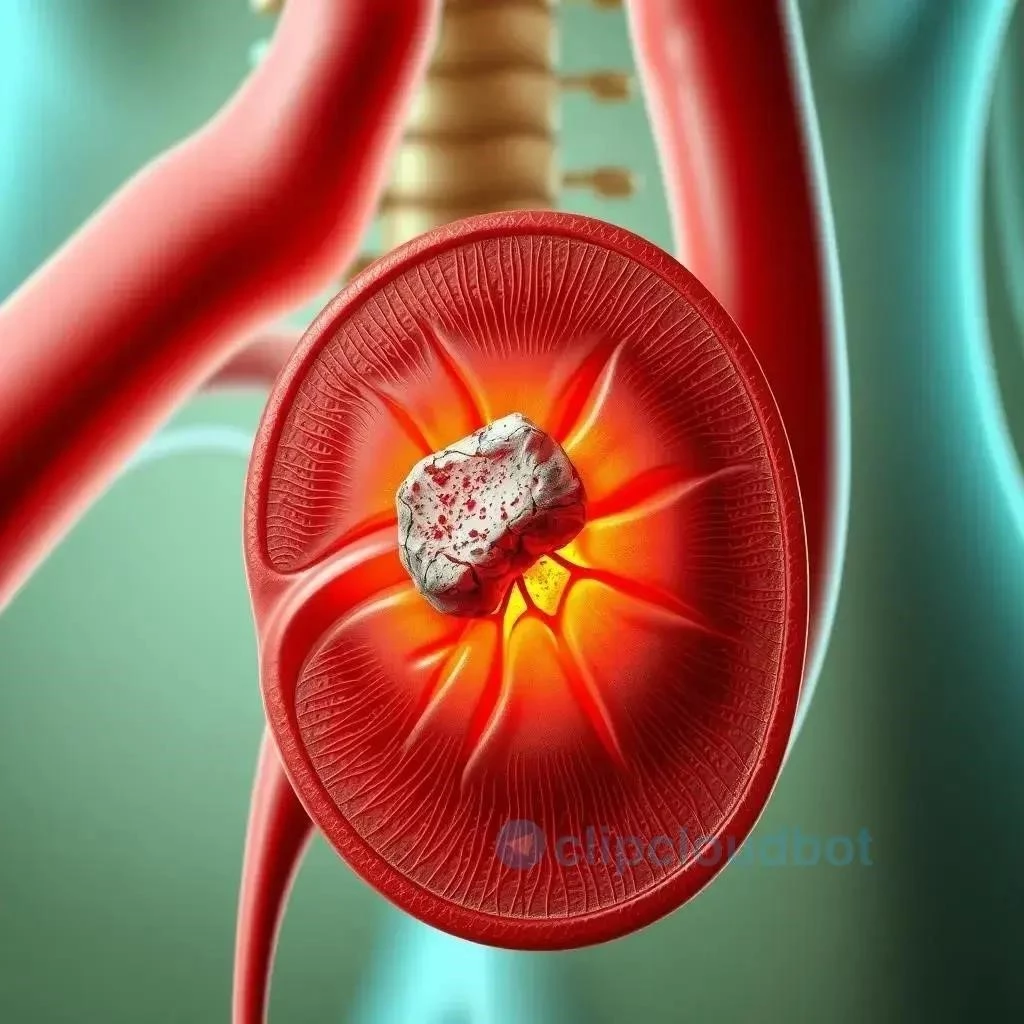Kidney Stones: Symptoms, Causes, Risk Factors, and Treatment Options
Symptoms of Kidney Stones
Kidney stones often present with excruciating pain, typically felt in the flank (the side of your back between your ribs and hips) or lower abdomen. This pain can radiate to the groin, and it may be intermittent, coming in waves as the stone moves through the urinary tract. The pain’s intensity can fluctuate, ranging from a dull ache to sharp, severe spasms.
Other common symptoms include blood in the urine (hematuria), which may cause the urine to appear pink, red, or brown. You might experience a persistent need to urinate, even if only small amounts are passed. Urination may also be painful or burning. Some individuals experience nausea and vomiting, and in some cases, a fever and chills may develop, indicating a possible infection. If you suspect kidney stones, seek medical attention promptly.
Causes and Risk Factors
Kidney stones form when certain substances in the urine become concentrated enough to crystallize. These crystals can grow into larger masses, ranging from tiny grains of sand to pebble-like formations, sometimes even larger. Several factors contribute to kidney stone development, including:
Dehydration:
Insufficient fluid intake is a major risk factor. When you don’t drink enough water, your urine becomes more concentrated, increasing the likelihood of crystal formation. Concentrated urine allows stone-forming minerals to come into closer contact and bind together.
Diet:
A diet high in certain substances, such as oxalate, sodium, and animal protein, can increase your risk. Oxalate, found in foods like spinach, rhubarb, and nuts, can bind with calcium in the urine to form calcium oxalate stones, the most common type. High sodium intake can increase calcium excretion in the urine, further contributing to stone formation. Excessive animal protein can also raise uric acid levels, promoting the development of uric acid stones.
Family History:
If you have a family history of kidney stones, you are at an increased risk. This suggests a genetic component that may influence how your body processes certain minerals.
Medical Conditions:
Certain medical conditions, such as inflammatory bowel disease, gout, hyperparathyroidism, and renal tubular acidosis, can disrupt the normal balance of substances in the urine and increase the risk of kidney stone formation. These conditions can alter the absorption and excretion of various minerals involved in stone development.
Medications:
Some medications, including certain diuretics, calcium-based antacids, and certain HIV medications, can contribute to kidney stone development. These medications can influence urine composition and mineral balance, potentially increasing the risk of stone formation.
Obesity:
Being overweight or obese is associated with an increased risk of kidney stones. Obesity can alter urine pH and increase urinary excretion of calcium and uric acid, promoting stone formation.
Sex and Age:
Men are generally more susceptible to kidney stones than women. Kidney stones are also more common in adults over 40, although they can occur at any age.
Understanding these risk factors can help you take proactive steps to reduce your chances of developing kidney stones. Consult with your healthcare provider to discuss your individual risk factors and develop a personalized prevention strategy.
Treatment Options
Treatment for kidney stones varies depending on the size and location of the stone, as well as the severity of symptoms. Small stones may pass naturally with increased fluid intake and pain management. Larger stones or those causing complications may require more invasive interventions.
Conservative Management:
For small stones (less than 5mm), the focus is often on facilitating their passage through the urinary tract. Drinking plenty of fluids helps flush the stone out, and pain relievers like ibuprofen or naproxen can manage discomfort. Your doctor may also prescribe an alpha-blocker medication to relax the muscles in the ureter, making it easier for the stone to pass. Regular monitoring and follow-up are essential to ensure the stone passes successfully.
Medical Expulsion Therapy:
This approach involves using medications to help expel the stone. Alpha-blockers, as mentioned above, can relax the ureter and facilitate passage. In some cases, other medications may be used to help dissolve certain types of stones, such as uric acid stones.
Shock Wave Lithotripsy (SWL):
SWL uses focused shock waves to break larger stones into smaller fragments that can be passed more easily. This non-invasive procedure is performed under sedation or anesthesia. After SWL, you may experience some discomfort and blood in your urine as the fragments pass. A strainer may be used to collect the fragments for analysis.
Ureteroscopy:
For stones lodged in the ureter, a ureteroscope, a thin, flexible tube with a camera, is inserted through the urethra and bladder into the ureter. The stone can then be visualized and removed with a small basket or grasped and broken up with a laser. This procedure is typically performed under anesthesia.
Percutaneous Nephrolithotomy (PCNL):
PCNL is used for very large or complex stones located within the kidney. A small incision is made in the back, and a nephroscope, a thin instrument with a camera and tools, is inserted directly into the kidney. The stone is then broken up and removed. PCNL typically requires a hospital stay and may involve the placement of a temporary nephrostomy tube to drain urine.
Surgery:
Open surgery for kidney stones is rare and typically reserved for highly complex cases where other treatment options are unsuitable. This involves a larger incision and a longer recovery period.
Choosing the appropriate treatment depends on various factors, and your doctor will discuss the best course of action based on your individual circumstances. Early diagnosis and prompt treatment can help prevent complications and improve outcomes.
Preventing Kidney Stones
Preventing kidney stones involves adopting lifestyle changes and, in some cases, medical interventions. The key is to reduce the concentration of stone-forming substances in your urine and address underlying risk factors.
Hydration:
Drinking plenty of fluids, especially water, is crucial for kidney stone prevention. Aim for at least 2-3 liters of fluid per day. This helps dilute your urine, preventing the crystallization of minerals. Monitor your urine color; pale yellow indicates adequate hydration. If you exercise vigorously or live in a hot climate, you may need to increase your fluid intake further. Consider carrying a water bottle and making a conscious effort to drink throughout the day.
Dietary Modifications:
Certain dietary changes can help reduce your risk. If you’re prone to calcium oxalate stones, limiting high-oxalate foods like spinach, rhubarb, nuts, and chocolate may be beneficial. Reducing sodium intake can also help lower urinary calcium levels. Moderating animal protein consumption can lower uric acid levels, reducing the risk of uric acid stones. A dietitian can provide personalized guidance based on your individual needs and stone composition.
Increase Citrate Intake:
Citrate, found in citrus fruits like lemons and limes, can help prevent calcium stones by binding with calcium in the urine. Increasing your citrate intake can be achieved through diet or citrate supplements. Adding lemon or lime juice to your water is a simple way to boost citrate levels.
Manage Underlying Medical Conditions:
If you have a medical condition that increases your risk of kidney stones, such as gout, inflammatory bowel disease, or hyperparathyroidism, managing the condition effectively is essential for preventing stone formation. Work closely with your healthcare provider to address these underlying conditions and minimize their impact on your urinary tract health.
In some cases, your doctor may prescribe medications to prevent kidney stone formation. These medications may include thiazide diuretics, potassium citrate, or allopurinol, depending on the type of stone you are prone to developing. These medications help regulate urine composition and reduce the concentration of stone-forming substances.
Regular Monitoring and Follow-up:
If you have a history of kidney stones, regular check-ups with your doctor are important. Monitoring your urine and blood can help detect any changes that might indicate a recurrence. Your doctor may recommend periodic imaging tests to check for new stone formation. Early detection and intervention can prevent complications and minimize the impact on your kidney health.
By adopting these preventive strategies and working closely with your healthcare provider, you can significantly reduce your risk of developing kidney stones and maintain optimal urinary tract health.






